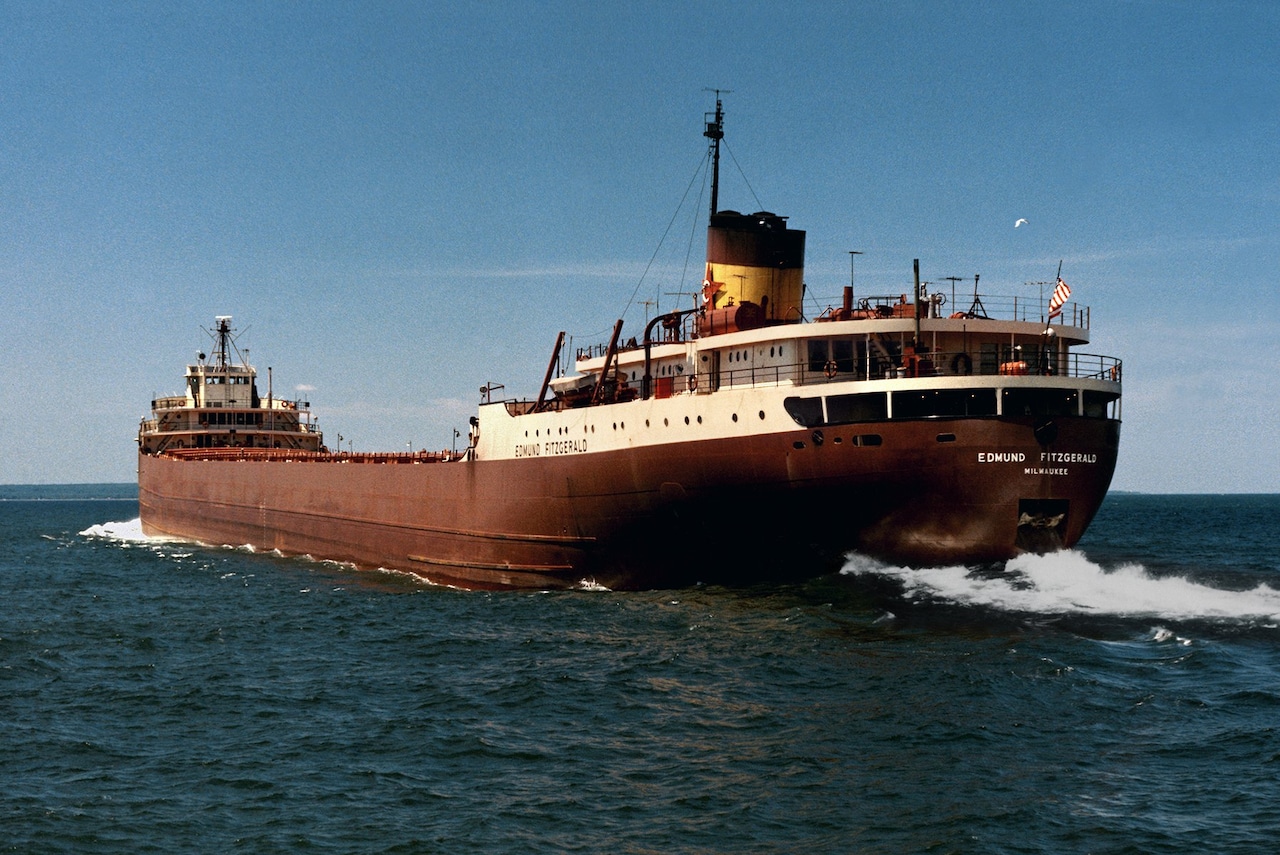Copyright M Live Michigan

DETROIT — “The Wreck of the Edmund Fitzgerald” by Gordon Lightfoot is a popular song and a cultural touchstone known to draw tears around the Great Lakes. But it hits differently for Darren Muljo. He was 5 years old when his grandfather, watchman Ransom Cundy, climbed aboard the SS Edmund Fitzgerald for the last time. Cundy, a former U.S. Marine from Lake Linden who served during World War II, survived the hell of Iwo Jima before his 30-year career as a mariner ended in a November gale. “It raises the hair on my neck every time I hear it,” said Muljo, a safety consultant from Marquette who will join others at the “musty old hall” in Detroit where a solemn bell rang over a sleeping city on Nov. 10, 1975, the night the Mighty Fitz went down. It’s been 50 years since Rev. Richard Ingalls rang the Mariner’s Church bell. In that half-century, the Fitzgerald has become something more than a shipwreck. It’s legend now — synonymous with the lake that swallowed her, occupying a singular place in Midwestern cultural lore. It’s simultaneously the most mysterious and the most well-known Great Lakes shipwreck, having sank long enough ago to be history, but recently enough to live in the memory of those alive at the time. Wreck sleuths have belabored the tale; a tragedy rendered so poignantly into verse that the story is now shaped as much by myth as by fact. Lightfoot’s song — the reference point for most — is beloved, but not wholly accurate. The ship was headed to Detroit, not Cleveland. And its lyrical suggestion that the hatchways did in the good ship is disputed — as is much about the Fitzgerald’s final moments and the subsequent efforts to discover and document what really happened that night. Lightfoot later changed the lyrics in live performances. Theories abound, but it’s unlikely we’ll ever know exactly why the ship sank despite advances in technology which could help shed light on its final moments. Emotional scars and legal safeguards have sealed its secrets for good. Regulations now essentially put the site off-limits and the restrictions aren’t just legal but cultural — reinforced by family activism and a song. Such forces protect the wreck but also limit inquiry into it. The wreck is in two pieces at the bottom of Lake Superior in Canadian waters. The Ontario government gatekeeps the site through dive-permitting criteria opaque enough that even organized float-overs of the wreck site feel compelled to seek permission. “The Edmund Fitzgerald gets really special treatment,” said John O’Shea, an anthropology professor and researcher who teaches a course in underwater archeology at the University of Michigan which includes listening to marine radio traffic from that fateful night. The Fitzgerald’s cult following is owed to the song and its status as the last major lake freighter to sink with substantial loss of life. That fuels a type of fetishism, O’Shea said, not mirrored for similar tragedies such as the sinking of the Carl D. Bradley with only two survivors in 1958 and the Daniel J. Morrell with one survivor in 1966. “I have to wonder, you know, what must the ghosts of that crew think when people have a swimming or kayaking event over the site of the wreck?” O’Shea said. “The mind kind of boggles at what they might have really thought with some of this stuff that goes on.” A controversial discovery that changed everything Ric Mixter was there when the spark that resulted in special restrictions at the Fitzgerald wreck site was lit. Mixter, a historian and diver from Marquette, was topside off Whitefish Point in July 1994 when a submersible carrying a tugboat owner and his son came upon a body floating near the hull. The discovery ignited a firestorm after the “Expedition 94” documentary crew organized by businessman Fred Shannon reported the discovery to Ontario police. Reporters were waiting for the expedition boat back at the dock. Fitzgerald crew families were aghast when Shannon published low-resolution imagery showing the unidentifiable body of a man in a life vest outside the hull near the bow. They exerted pressure through lawmakers to try and stop the publication, to no avail. Muljo’s mother, Cheryl Rozman, likened it to digging up a cemetery and Muljo today remains sharply critical of the decision, calling it “pretty disgusting” commercialization. “Many of the family members never felt respected in the aftermath, because of the nature of how that stuff was released,” Muljo said. But Mixter, who produced and directed the expedition documentary, argues that the 1994 expedition has been unfairly vilified. They didn’t go looking for bodies and, when they found one by chance, they didn’t publish anything graphic. Shannon turned down big money offers for the footage before his death, Mixter said. “We were caught in this horribleness of ‘if we don’t show something, they’re going to say we’re lying,’” Mixter said. “We never used a close-up. We never identified the person. We never tried to make it into a headline-busting thing.” What Mixter and Muljo both agree on is that the wreck site would likely not be restricted today absent the 1994 discovery. The controversial expedition and its aftermath galvanized a loose collection of disparate Fitzgerald families into collective action. Within a year, the Great Lakes Shipwreck Museum at Whitefish Point had organized a dive to retrieve the ship’s bell, giving families a tangible memorial and a place to grieve. The next part took a bit longer. It was another 10 years before the Ontario government amended its Heritage Act in 2005 to provide more aggressive restrictions on diving the wreck site. Dan Schneider, a consultant and former senior policy advisor with the Ontario Ministry of Culture and Tourism who helped develop the restrictions at the Fitzgerald wreck site, said two factors made the case for “extra special protections.” One was the presence of human remains in a cold, deepwater environment where they are well-preserved. The second was the wreck’s cultural significance. “Yes, the song was pivotal to the change in the law,” Schneider said. Not only was it written and performed by a Canadian, but it elevated public interest into the wreck high enough to draw diving expeditions. “Not all shipwrecks are created equal,” said Schneider. “People who like to dive on shipwrecks aren’t necessarily archeologists and that’s where the real friction comes from,” he said. Will we ever go back to the Fitzgerald? The twisted, broken hull of the Fitzgerald rests on a seam between two nations and a fissure in perspectives. In physical space, it lies on the international border close to American waters roughly 17 miles off Whitefish Point. In metaphorical space, it intersects ethical debates about shipwreck diving, preservation and veneration. The bell was recovered at the behest of family members, but not everyone was supportive of removing part of the wreck — which is an act broadly prohibited throughout the Great Lakes. Mixter, who sits on the Great Lakes Shipwreck Historical Society board of directors, was initially opposed to the recovery but has since changed his tune. “A lot of us thought that that’s the soul of the ship, that it shouldn’t come up,” Mixter said. But the raw emotion the bell evokes has changed his thinking over the last 25 years. “I’ve seen family members weeping at the bell and I’ve seen people who have no connection to the crew weeping at the bell. And I know the power of that.” The last known dive on the Fitzgerald came a few months after the July 4, 1995 bell recovery, when two divers, Terrence Tysall and Mike Zee, used trimix gas to complete a scuba trip down and back. The dive community likened it to paying respects in a cemetery at severe personal risk while Fitzgerald family members called it reckless and intrusive. The scuba dive added more weight to the push for stricter site rules. Ontario law now treats the wreck as a “watery grave” and prohibits any dives, submersible or research equipment use within a 500-meter radius without a special permit — which has never been granted. Technically, it’s not a “ban.” But it’s worked as a de-facto moratorium in practice. Even surface float-over ceremonies such as this year’s 411-mile relay swim feel compelled to seek a permit — although whether they actually need one isn’t certain. “You can sail over top of the Edmund Fitzgerald any time you want,” Mixter argues. Because of its proximity to a shipping lane, “every sailor goes over the top of it.” The provincial policy of absolute reverence to the position of family members and cultural veneration of the Fitzgerald bothers Mixter, who argues that together they magnify public misunderstanding, turning a permit system into a folklore of outright prohibition which feeds the belief that even floating over the wreck requires permission. Comparable sites aren’t similarly fenced off, Mixter said. “There are 25,000 grave sites in the Great Lakes. We don’t ask permission to go and visit any other ones.” There’s also an element of overshadow, he said. “Nobody talks about the 10,000 other shipwrecks,” Mixter said. “It’s been 50 years now and we only talk about it because of the Gordon Lightfoot song. We don’t talk about the Bradley or the Morrell this way, or ring a bell for the Novadoc or the Minch or any of the ships that lost a lot more people.” Questions about diving the site are inevitably referred to the Ontario Ministry of Heritage, Sport, Tourism and Culture, which did not answer queries about what would qualify for a permit - or who has applied for them. O’Shea speculated that “a legitimate survey” which could be justified on scientific grounds might potentially secure a permit. “If I were advising, I’d probably allow something like that,” he said. But opening the 530-foot-deep wreck to just any diving could result in more deaths. “There are a lot of wannabees that aren’t trained to work at that depth who would be tempted to do it, I suspect,” he said. Muljo said Fitzgerald families don’t want to see any more dives and vowed to ensure any permit applications go through a “very, very thorough review to find out exactly what the true intention is on anybody that would wish to dive.” He believes calls to “solve the mystery” often mask the urge to promote a pet theory. “And what does that theory do? It puts them on stage speaking to people because they found out the ‘true reason’ why the Fitzgerald sank,” he said. “I don’t believe any of them are truly interested in the archeological nature, except they want to be the next deepwater detective who could come back and sell a book, a video, or stand on stage for years to come and say that they’re a person who finally closed that chapter.” Muljo said an expedition sponsored and led by the Canadian government “with their own interest in documenting an archeological site where they would be in charge and lead the whole thing is the only way I could ever see another dive happen.” “And I don’t think they have that interest,” he said.



